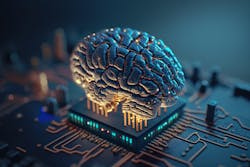CONTROLS | How can AI rewrite the lighting controls value proposition?
The history of the lighting industry is a testament to an unyielding spirit of innovation. From the ingenuity that launched the incandescent lightbulb to the vision realized in energy-efficient LEDs, the lighting and controls sector has consistently sought to improve human experience and reach new levels of sustainability. Today, we stand on the precipice of another leap forward, with artificial intelligence promising to propel the next evolution of lighting functionality and controllability. However, we cannot build a roadmap for AI without understanding what it truly is and the role it can play in adding more value to lighting technology and the built environment it serves.
Building blocks of AI
Before we delve into discussing the applications of AI in lighting control systems, it is essential to know the fundamentals of AI.
Artificial intelligence refers to the simulation of human intelligence in machines by a range of processes, including learning, reasoning, and self-correction, that enable computers and other devices to replicate human cognitive abilities. Through these processes, AI systems can adapt and improve their performance over time, thus becoming more effective and efficient at solving problems and executing tasks.
It is important to distinguish between AI as it exists and its fictional portrayals often seen in popular media. Fictional characters such as “The Terminator” or Star Wars’ C-3PO tend to depict AI as self-aware or conscious machines, which is an inaccurate representation of current AI technology. Although AI systems can perform complex tasks and exhibit a degree of autonomy, they do not possess true self-awareness or consciousness, making them fundamentally different from the sentient machines often portrayed in fiction.
AI is built on three key building blocks: storage, training data, and processing power. Hardware and software storage is essential for managing the vast amounts of information that AI systems must process to function effectively. This includes diverse training data as well as any resources needed for ongoing learning and optimization. Training data is the foundation for AI algorithms, as it provides examples from which the systems learn patterns and draw inferences. Finally, AI systems demand high levels of processing power to perform the complex computations that analyze, learn from, and act upon the data they are provided.
Intersection of digital control and AI
Conventional lighting control systems were mostly analog, relying on 0–10V technology for dimming based on voltage increases and decreases. More sophisticated digital systems allow bidirectional data exchange. The advent and adoption of standardized digital control protocols, such as DALI-2 D4i, provide a supportive framework for adding AI to lighting control systems. These protocols enable lighting systems to be powered and to access vast amounts of data via a common interface between compatible devices from various manufacturers. By creating a consolidated communication and data management framework, the DALI-2 D4i standard streamlines the transmission of data — a rich resource for AI algorithms.
Effective management of modern, large-scale lighting networks is more than just dimming and scheduling. AI systems can analyze vast amounts of data in real time, adjusting lighting settings based on factors such as occupancy, ambient light, and energy consumption. In contrast, standard lighting control systems have limited data processing capacity, restricting their ability to optimize performance.
Adaptive intelligence equips AI systems to continuously learn and refine their decision-making processes, unlike standard control systems, which follow fixed rules and may struggle to adapt to changes in occupant behavior and lighting usage.
Additionally, AI systems excel in managing large, complex installations with multiple nodes and intricate control requirements. While standard lighting control systems may require frequent manual intervention to maintain performance, AI-driven systems can efficiently manage complex operations with minimal human input.
AI integration into lighting systems also presents an opportunity for predictive maintenance, particularly for LED drivers. Utilizing machine learning and the data available from DALI-2 D4i certified LED drivers, systems can analyze trends in usage and performance to anticipate potential faults before they occur. They can signal the need for maintenance, replacement, or system optimization in a timely manner, preventing disruptions, reducing maintenance costs, and enhancing the longevity of the lighting system through more efficient power management. AI bolsters sustainable, efficient, and resilient lighting infrastructures by transforming maintenance from a reactive task into a proactive strategy.
Furthering an AI value proposition
The notion of return on value (ROV) amplifies the traditional understanding of return on investment (ROI) in the context of lighting control systems. ROV is a comprehensive approach, assessing not only the direct monetary returns but also the strategic, operational, and qualitative aspects. In the case of AI-enabled lighting control systems, these include the benefits from predictive maintenance, optimized control strategies, and efficient network management. All these elements collectively contribute to maximizing value, promoting a shift from cost-centered evaluation to value-centered assessment.
Therefore, ROV becomes a key factor when deciding to invest in lighting control systems. We have established that predictive maintenance can minimize downtime, enhance the lifespan of lighting components, and reduce maintenance costs and time, which also contributes to labor savings. In parallel, AI-optimized control strategies can improve energy efficiency, contributing to a reduction in carbon footprint — a value proposition that extends beyond monetary savings.
The financial quantification of these intangible benefits might pose a challenge, but they are still crucial in completing the value picture. Take the energy savings achieved by optimized lighting control strategies. While it is straightforward to compute savings in energy costs per kilowatt-hour, the corresponding reduction in carbon emissions contributes to an organization’s sustainability goals — a value that is hard to express in monetary terms. Similarly, the labor savings resulting from efficient network management can improve worker productivity and satisfaction, contributing to a better organizational culture. When aggregated, these qualities make a compelling case for the ROV approach and underscore its importance as an integral part of ROI calculations for lighting control systems.
It is important to note that AI-enabled lighting control systems may not be ideal for every lighting installation. They are particularly well suited for large-scale applications with a sizable number of nodes and substantial data generation. In such cases, AI-driven solutions can effectively harness the wealth of data to optimize performance, adapt to changing conditions, and manage complex installations with ease. For smaller-scale lighting systems with less complexity and fewer nodes, the benefits of AI may not be as pronounced as the data set is smaller. In these applications, standard control systems may suffice, although with the rising popularity of household digital assistants, there is potential to bring some version of these advanced technologies to smaller networks.
AI is a transformative force that can redefine what is possible in the realm of lighting control. Our charge as an industry is to turn the concepts of AI into practical, value-add control technologies and systems, commercializing innovations that will not only enrich our industry but also make a lasting, positive impact on our planet and its people.
*Inventronics manufactures DALI-certified LED drivers such as those mentioned in this article.
LANDON MILES is technical marketing manager for intelligent products, based in Oklahoma, for Inventronics, a manufacturer of LED drivers, sensors, control systems, and LED modules.
Follow our LinkedIn page for our latest news updates, contributed articles, and commentary, and our Facebook page for events announcements and more. You can also find us on Twitter.
Landon Miles
LANDON MILES is the technical marketing manager for intelligent products at Inventronics, a manufacturer of LED drivers, sensors, control systems, and LED modules. Miles has nearly a decade of experience working with Inventronics, progressing through various roles from field applications services to technical marketing manager. He provides training, collaborates with engineering teams, and develops materials relating to new products, customer partnerships, and marketing processes for the lighting controls systems business. He has a bachelor’s degree in computer information systems from Arizona State University.







